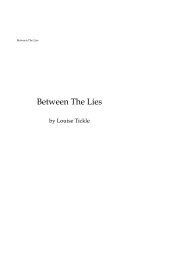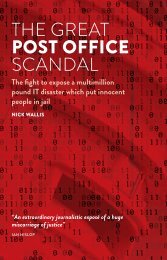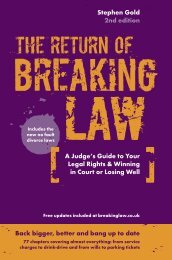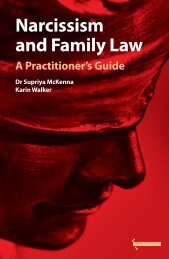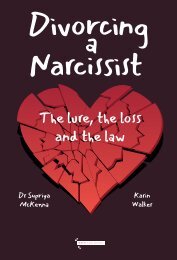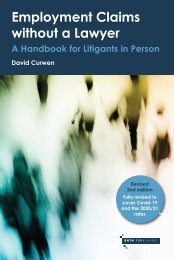Insolvency Made Clear: A Guide for Debtors
Plain English, practical guidance for anyone facing demands over a debt they are struggling to pay.
Plain English, practical guidance for anyone facing demands over a debt they are struggling to pay.
Create successful ePaper yourself
Turn your PDF publications into a flip-book with our unique Google optimized e-Paper software.
<strong>Insolvency</strong> Law <strong>Made</strong> <strong>Clear</strong> – A <strong>Guide</strong> For <strong>Debtors</strong><br />
• Finally, <strong>for</strong> a preference which is not a transaction at an undervalue and<br />
not given to an associate, it is six months ending with the day the petition<br />
is presented.<br />
If the Trustee’s application is successful, the court will “make such order as it<br />
thinks fit <strong>for</strong> restoring the position to what it would have been if that individual<br />
had not entered into that transaction”. The order the Trustee typically applies <strong>for</strong><br />
is an order to undo the transaction or preference. For example, it would be to<br />
reclaim the money paid to the parents, who would then be repaid at the same<br />
proportion as all of the other creditors. However, the court has wide powers to<br />
make the appropriate order to undo the transaction. In the example of the car<br />
sold at an undervalue, the Trustee might ask simply <strong>for</strong> the excess £5,000 to be<br />
repaid rather than undoing the whole transaction and receiving a £10,000 car.<br />
There is some protection given <strong>for</strong> third parties who are affected by transactions<br />
at an undervalue or preferences where they can show that they acquired the<br />
property in good faith and <strong>for</strong> value under s342 of the Act. Where the person<br />
did not deal directly with the bankrupt, they cannot be required to pay any<br />
money back or undo the transaction. Even where they did deal directly, the<br />
order will not undo the transaction. An example where this matters is where<br />
there is a transfer of shares which are later worth more: the Trustee cannot ask<br />
<strong>for</strong> a return of the shares.<br />
However, if the third party was aware that the individual was likely to go bankrupt<br />
and that the property was at an undervalue, or if they were an associate of<br />
that individual, then it will be presumed that they were not acting in good faith.<br />
The third party will be able to bring evidence to rebut this presumption.<br />
It is a defence to a claim under these sections if it can be shown that the bankrupt<br />
was solvent at the time and did not become insolvent as a consequence of<br />
the transaction. If that was the case, then the creditors were not prejudiced by<br />
the transaction or preference, since (at that time) they could still be repaid by<br />
the bankrupt. The bankrupt’s insolvency is presumed if the transaction was to<br />
an associate.<br />
These claims can be brought even after the bankruptcy is discharged. The money<br />
returned by the claim will be distributed to the creditors as if it was an asset of<br />
the estate during the bankruptcy. A Trustee has six years to bring a claim <strong>for</strong> the<br />
return of money and 12 years <strong>for</strong> any other remedy.<br />
The court has discretion to make the order it thinks fit. This includes making<br />
no order at all. In Bucknall v Wilson [2020] EWHC 1200 (Ch) the bankrupt<br />
instructed his stepdaughter to provide accountancy services <strong>for</strong> which he owed<br />
her £99,330. The bankrupt paid his stepdaughter and all his other creditors<br />
rather than repay a judgment debtor against whom he had a personal grudge.<br />
22



